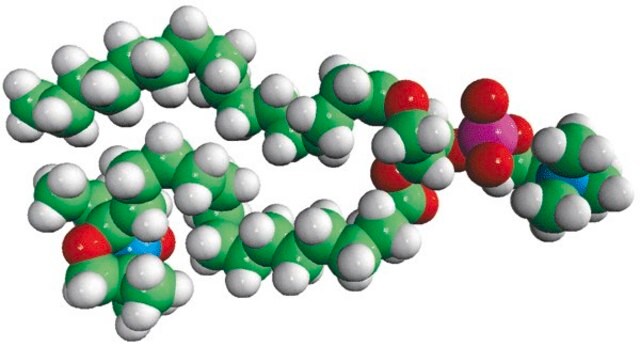810601P
Avanti
16:0-5 Doxyl PC
Avanti Research™ - A Croda Brand 810601P, powder
Synonyme(s) :
1-palmitoyl-2-stearoyl-(5-doxyl)-sn-glycero-3-phosphocholine
Sélectionner une taille de conditionnement
1 010,00 $
Sélectionner une taille de conditionnement
About This Item
1 010,00 $
Produits recommandés
Essai
>99% (TLC)
Forme
powder
Conditionnement
pkg of 1 × 1 mg (810601P-1mg)
Fabricant/nom de marque
Avanti Research™ - A Croda Brand 810601P
Type de lipide
ESR probes
phospholipids
Conditions d'expédition
dry ice
Température de stockage
−20°C
Description générale
Application
- as a component in virus-like large unilamellar vesicles (VL LUVs) to quench 4-chloro-7-nitrobenz-2-oxa-1,3-diazole (NBD) fluorescence emission[6]
- in the preparation of multi-lamellar vesicles (MLVs) as a site-specific quencher to perform fluorescence quenching studies[7]
- in the preparation of spin-labelled multi-lamellar vesicles (MLVs)[8]
Actions biochimiques/physiologiques
Conditionnement
Notes préparatoires
Informations légales
Souvent commandé avec ce produit
Code de la classe de stockage
11 - Combustible Solids
Faites votre choix parmi les versions les plus récentes :
Certificats d'analyse (COA)
It looks like we've run into a problem, but you can still download Certificates of Analysis from our Documents section.
Si vous avez besoin d'assistance, veuillez contacter Service Clients
Déjà en possession de ce produit ?
Retrouvez la documentation relative aux produits que vous avez récemment achetés dans la Bibliothèque de documents.
Notre équipe de scientifiques dispose d'une expérience dans tous les secteurs de la recherche, notamment en sciences de la vie, science des matériaux, synthèse chimique, chromatographie, analyse et dans de nombreux autres domaines..
Contacter notre Service technique







